- We all have heard about summer or winter crops, but do we know why they are differentiated by seasons? Why are they specific for a certain season to sow and subsequent flowering? Well, the answer is for Photoperiodism. But what is this photoperiodism? If you want to know about photoperiodism, this article is for you. In this article details about photoperiodism, types of plants based on photoperiod, photoperiodic induction and floral hormone are described.
What is Photoperiodism?
Plants respond to light and dark. They require a certain length of light and dark period to flower which is known as photoperiod (photo means light; period means time). The response of plants to the photoperiod, i. e, relative length of light and dark (day and night) period is known as photoperiodism.
Note: In summer, day length is long and night length is short and in winter it is vice versa. Summer crops are those plants that are sown in summer and ripen in the winter. Again winter crops are sown in winter and ripen in summer.
In 1920, two plant physiologists, W. W. Garner and H. A. Allard, first discovered photoperiodism. They worked on two plants-
a) Biloxi variety of Soybeans (Glycine max):
They sowed the seed at different times of year and observed that they flower at almost the same time.
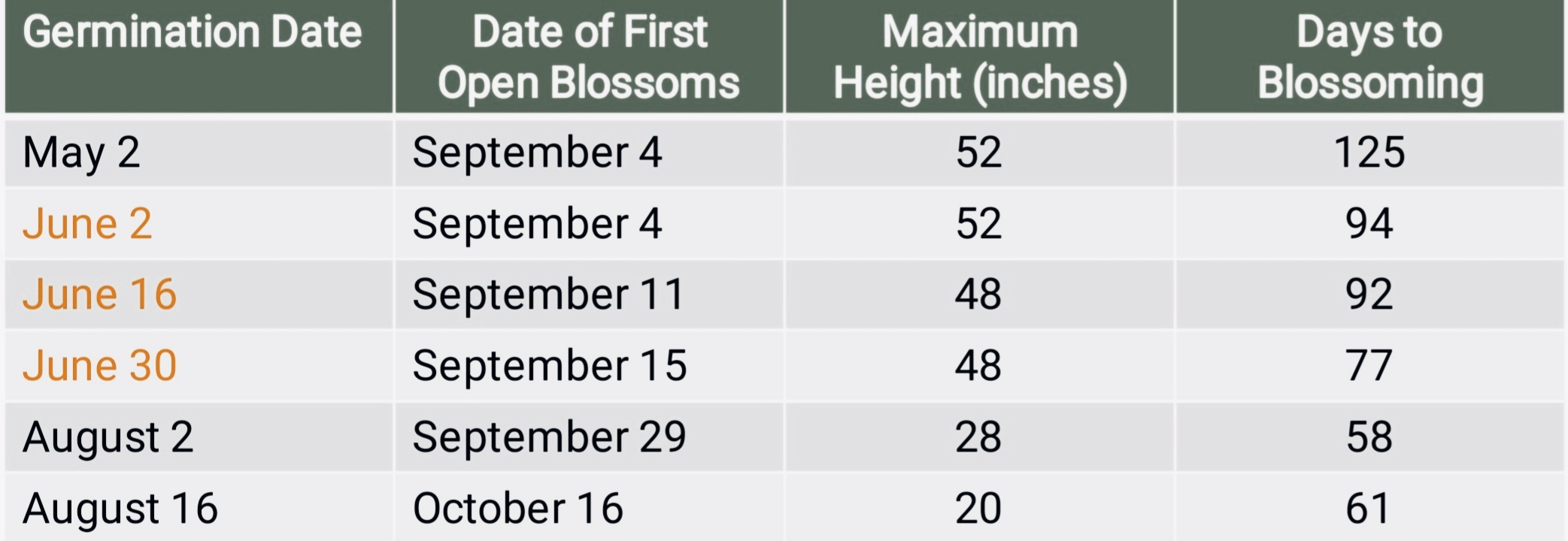
Conclusion
There is a seasonal timing mechanism for flowering in soybean.
*Plant grows more if the vegetative stage is long. On the other hand, the short vegetative stage reduces plant growth.
b) Maryland Mammoth:
Maryland Mammoth is a mutant of tobacco Maryland (Nicotiana tabacum). Maryland tobacco is narrow-leaved, commercial variety, winter crop that flowers in the summer. On the other hand, Maryland Mammoth is a mutant variety, large-leaved, summer crop which flowers in the winter, when day length is short.
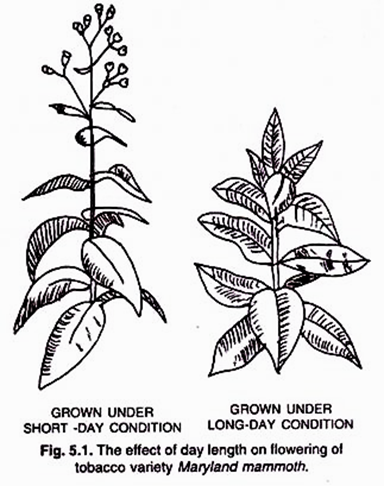
Conclusion
- The length of the day controls flowering.
- Maryland Mammoth is a short-day plant (SDP).
Classification
Depending on the duration of photoperiod, plants can be classified as-
- Short-day plants (SDP),
- Long day plants (LDP),
- Day-neutral plants,
- Long short day plants and
- Short long-day plants.
1. Short long-day plants (SDP): Also known as long-night plants. These plants flower when the day length is less than a certain critical length. They generally flower in the early spring or autumn.
Example: Biloxi variety of soybeans (Glycine max), Maryland Mammoth variety of tobacco (Nicotiana tabacum), Cocklebur (Xanthium strumarium) etc.
*Critical length differs from species to species.
2. Long day plants (LDP): Also known as short night plants. These plants flower when the day length is more than a certain critical length. They generally flower in late autumn or early summer.
Example: Henbane ( Hyoscyamus niger), onion (Allium cepa) etc.
3. Day-neutral plants (DNP): The length of day and night has no effect on these plants. They flower in all photoperiods ranging from 5-24 hours of continuous exposure.
Example: Tomato, cotton, sunflower etc.
4. Long short day plants: These are mainly short-day plants but require long days during the early stage of growth for subsequent flowering.
Example: Bryophyllum.
5. Short long day plants: These are mainly long-day plants but require short days during the early stage of growth for subsequent flowering.
Example: Certain varieties of wheat (Triticum) and rye (Secale).
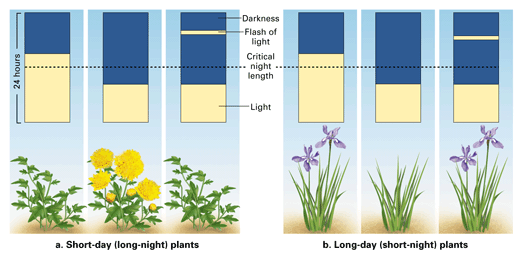
Photoperiodic Induction
The relative length of day and night is known as photoperiod. An appropriate photoperiod in 24 hours cycle constitutes one inductive cycle. Plants require one or more inductive cycles for flowering. The number of inductive cycles required for flowering differs from species to species. If a plant receives sufficient inductive cycle in an unfavourable photoperiods, it still flowers. This means flowering also occurs if a plant receives inductive cycles after intervals of unfavourable photoperiods, i. e., discontinuous inductive cycles. It is called photoperiodic induction.
- An increase in the number of inductive cycles can cause early flowering. For example, Xanthium (SDP) needs one inductive cycle and 64 days for flowering. But it can flower in 13 days if provided with 4-8 inductive cycles.
- Continuous inductive cycles help more in early flowering than discontinuous inductive cycles.
- Some plants require more than one inductive cycle. For example, Biloxi soybean (SDP) requires two inductive cycles, Salvia occidentalis (LDP) requires 17 inductive cycles, Plantago lanceolata (LDP) requires 25 inductive cycles.
Photoperiodic Stimulus or Floral Hormone
1. Perception of the photoperiodic stimulus and presence of a floral hormone:
Photoperiodic Stimulus is perceived by leaves, as a result, a floral hormone is produced in the leaves which is then translocated to the apical tip and initiates floral primordia.
Experiment on cocklebur (Xanthium pennsylvanicum); a short day plant shows the result:
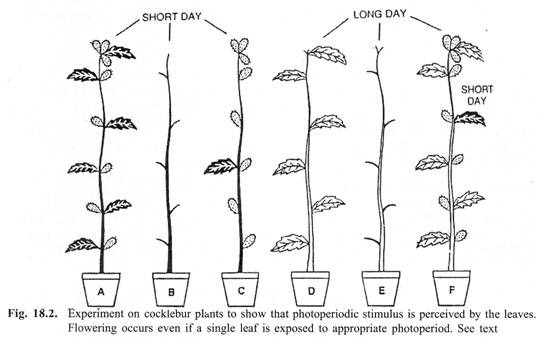
- In short-day conditions, cocklebur plants flowers. But if it is defoliated (i. e., all the leaves are removed from the plant), it doesn’t flower. Flowering also occurs even if a single leaf remains in the plant. (Fig. 18.2; A, B, C)
- In long-day conditions, the plant will not flower whether it is intact or defoliated. But if even one leaf is kept under short-day conditions, and the rest are under long-day conditions, flowering also occurs. (Fig. 18.2; D, E, F)
2. Transmission of the photoperiodic stimulus:
Another experiment on a two-branched cocklebur plant shows that-
- If one branch is exposed to short day condition and the other to long-day conditions, flowering occurs in both branches. (Fig. 6.16; 1)
- If the branch kept in the short-day condition is defoliated except one leaf, flowering also occurs in both the branches. (Fig. 6.16; 2)
- But if all the leaves of the short day branch are removed, flowering does not occur at all. (Fig 6.16; 3)
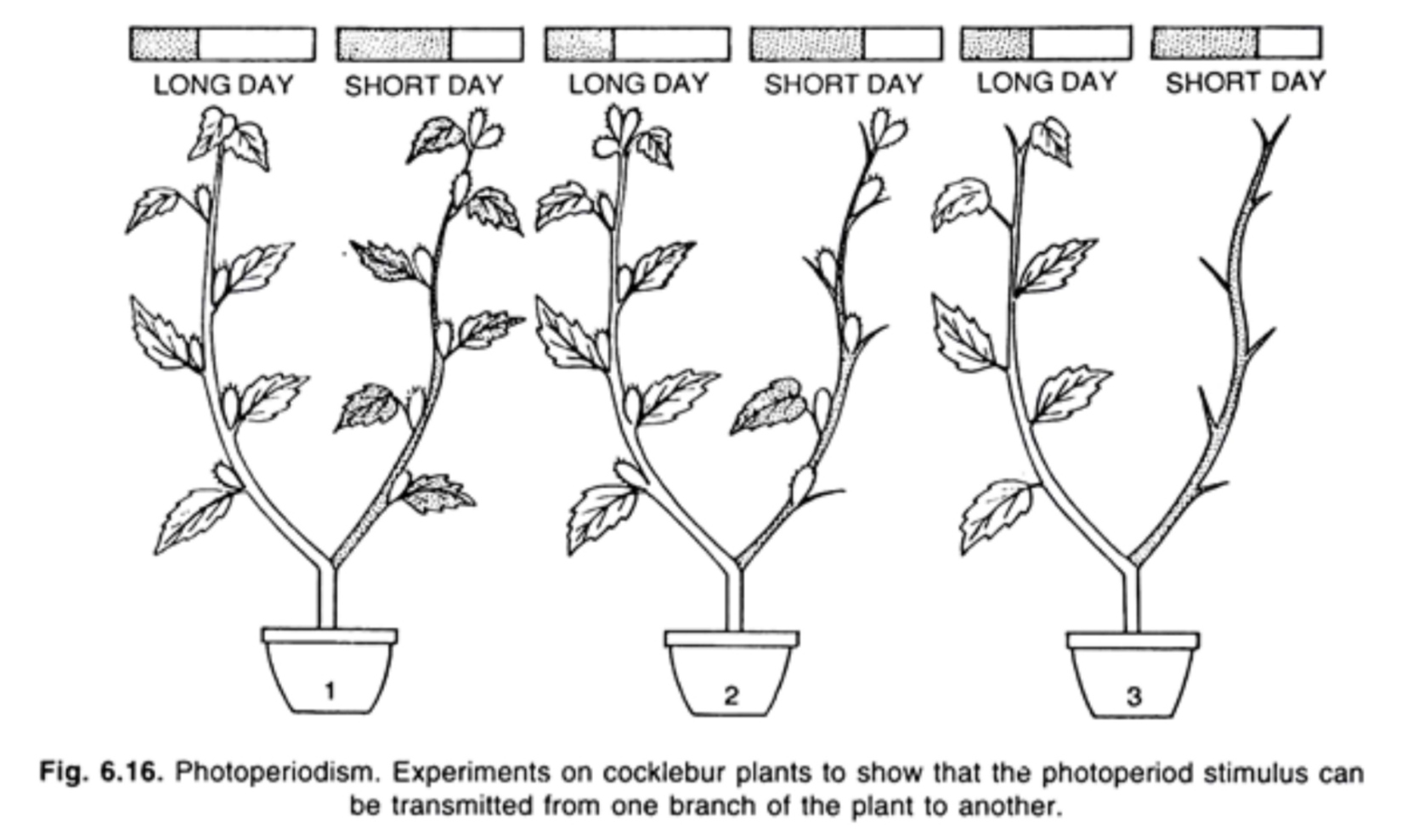 These experiments prove that photoperiodic stimulus is perceived by leaves and can transmit from one branch of a plant to another branch.
These experiments prove that photoperiodic stimulus is perceived by leaves and can transmit from one branch of a plant to another branch.
3. Translocation of stimulus:
Another experiment on cocklebur plant,

- If a cocklebur plant, exposed to short-day conditions is grafted to another cocklebur plant and kept under long-day conditions, flowering occurs on both the plants. (Fig 18.4; B)
- But if a cocklebur plant is grafted to another cocklebur plant both of them is kept under long-day conditions, flowering doesn’t occur at all. (Fig 18.4; C)
Again, these experiments prove that photoperiodic stimulus can translocate from one plant to another.
Florigen
Photoperiodic Stimulus or floral hormone is named florigen (Lat. Flora- flower, Gr. Genno-beget) by Mikhail Chailakhyan. In response to the appropriate photoperiod, a floral hormone is produced in leaves.
- But still, florigen is a hypothetical hormone. Scientists predicted that the hormone is very fragile, for this reason it cannot be extracted.
- It is composed of Gibberellin and Anthocyanin.
Again experiment!
LDP (Short day condition) = No flowering
LDP (Short day condition)+ Gibberellin= Flowering
SDP (Long day condition)+ Gibberellin= No flowering
- These experiments clearly show that Gibberellin activates in the appropriate photo inductive cycle and causes flowering.
- It is also indicated that the floral hormone is identical in short-day and long-day plants. Short-day plants require Anthesine and long-day plants require Gibberellin for flowering.
- But both Anthesine and Gibberellin are also hypothetical hormones. They together compose the photoperiodic stimulus; florigen.
References & Other Links
- Fundamentals of Plant Physiology by Dr. V. K. Jain.
 Plantlet The Blogging Platform of Department of Botany, University of Dhaka
Plantlet The Blogging Platform of Department of Botany, University of Dhaka
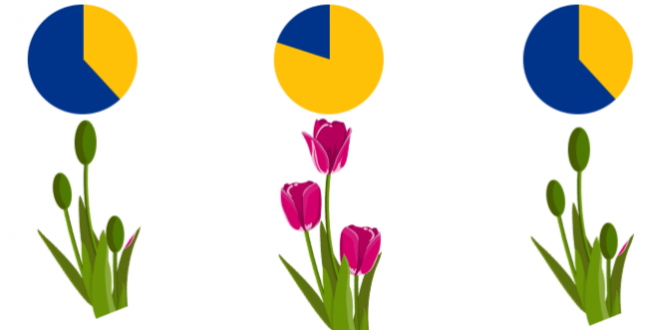

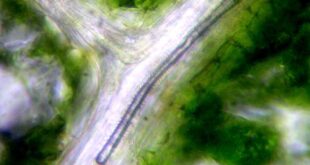
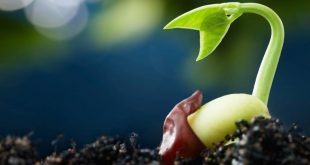
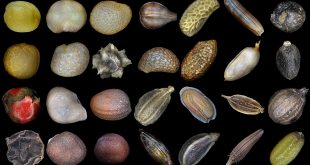
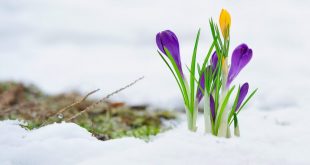
Keep it up. All the best.
I am grateful for your support.